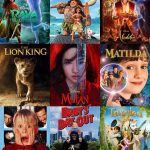Top Animated Movies of All Time: Which One is Your Favorite?

Related Movies:
Related Movies:
Related Movies:
Related Movies:
Related Movies:
Related Movies:
MULAN (2019)
The 2019 live-action adaptation of Mulan reimagines the iconic 1998 animated film, bringing the beloved story to life with a more grounded and realistic tone. Directed by Niki Caro, this version stays true to the core themes of bravery, honor, and sacrifice, but offers a more dramatic and epic approach, distancing itself from the musical elements of the original.
Set in ancient China, Mulan follows the journey of a young woman who disguises herself as a man to take her sick father’s place in the army, defying societal expectations to protect her family and serve the Emperor. The film features stunning cinematography and sweeping visuals, capturing the grandeur of the Chinese landscape and the scale of the war. The action scenes are intense, with impressive martial arts choreography showcasing Mulan’s growth from a naïve girl into a fierce warrior.
The performances, particularly by Liu Yifei as Mulan, are powerful and emotionally resonant. Her portrayal brings a grounded depth to the character, focusing on Mulan’s internal conflict and her desire to honor her family while staying true to herself. Donnie Yen, as Commander Tung, provides a wise and experienced mentor figure, while Jet Li’s Emperor adds gravity to the film’s themes of loyalty and honor.
One of the biggest changes in this adaptation is the absence of the songs that defined the animated version, though the film does incorporate some familiar musical motifs into its score. Instead, the 2019 Mulan places more emphasis on character development, cultural accuracy, and the philosophical aspects of war and leadership.
While the 2019 film doesn’t feature the same whimsical charm as the animated classic, it presents a more serious, action-oriented take that is rooted in Chinese culture and history. It’s a film about self-discovery, resilience, and the universal desire to fight for what’s right, with a strong emphasis on female empowerment.
Ultimately, Mulan (2019) is an epic reimagining that, while different in tone and style, remains a compelling and visually captivating tribute to the legendary story of a courageous woman who defied the odds.
FROZEN (2013)
Frozen is a modern Disney classic that combines adventure, magic, and heartfelt emotion in a story of sisterhood, courage, and self-acceptance. Set in the kingdom of Arendelle, the film follows two sisters, Elsa and Anna, as they navigate the challenges of Elsa’s magical ice powers. Elsa, the elder sister, isolates herself after inadvertently plunging the kingdom into eternal winter. Anna, determined and fearless, embarks on an adventurous journey to find Elsa and bring her back home.
The animation is breathtaking, with the icy landscapes and snow-filled vistas adding a layer of wonder to the story. The music, composed by Kristen Anderson-Lopez and Robert Lopez, became iconic, particularly the song “Let It Go,” which became a global anthem of empowerment. Elsa’s powerful transformation and her iconic performance of “Let It Go” became central to the film’s emotional core.
The relationship between Elsa and Anna is the heart of the film. Elsa’s internal struggle to control her powers and the fear of hurting those she loves contrasts with Anna’s determination to save her kingdom and reconnect with her sister. The film touches on themes of love, fear, and self-discovery, emphasizing that true strength comes from embracing who you are and finding the courage to be open with others.
Supporting characters like the charming ice harvester Kristoff, his reindeer Sven, and the lovable snowman Olaf bring humor, heart, and warmth to the film, providing comic relief and embodying the theme of friendship.
Frozen became a cultural phenomenon, celebrated for its beautiful animation, memorable songs, and strong female characters. It’s a story about the power of love and the importance of family, showing that no matter the challenges you face, love is always the key to overcoming adversity. The film’s success has cemented it as one of Disney’s most beloved animated features.
MOANA (2016)
Moana is a visually stunning and culturally rich Disney animated film that tells the story of a brave young girl who sets out on a daring journey to save her people. Set in the Polynesian Islands, the film follows Moana, the daughter of the village chief, who feels torn between the expectations of her family and her deep yearning to explore the vast ocean beyond her island home.
The animation in Moana is breathtaking, with vibrant depictions of the ocean, islands, and magical creatures, capturing the beauty of the Pacific Islands. The sea itself is portrayed almost as a character, offering both challenges and guidance to Moana during her adventure.
The film’s music, composed by Lin-Manuel Miranda, Opetaia Foa’i, and Mark Mancina, is one of its most standout features. Songs like “How Far I’ll Go” and “You’re Welcome” became anthems, with “How Far I’ll Go” in particular resonating with themes of self-discovery and determination. Moana’s journey of self-empowerment is supported by her interactions with the demigod Maui, voiced by Dwayne “The Rock” Johnson. Maui is a brash yet lovable character who helps Moana learn more about herself, her heritage, and the courage to face her destiny.
The film explores themes of identity, bravery, and the importance of understanding and respecting one’s heritage. Moana’s strength lies not in physical prowess but in her ability to trust in herself, her beliefs, and her instincts. Her journey is one of growth, as she learns that her true purpose lies in embracing her roots while forging her own path.
The voice performances, particularly by Auli’i Cravalho as Moana, are heartfelt and authentic, and the film does an excellent job of celebrating Polynesian culture in a respectful and meaningful way.
Overall, Moana is a powerful and uplifting film that captures the spirit of adventure, self-discovery, and the power of family. With its memorable songs, stunning visuals, and strong message of resilience, it has become a beloved classic in Disney’s animated film lineup.
TANGLED (2010)
Tangled is a delightful Disney animated film that reimagines the classic story of Rapunzel with a modern twist. The film follows the adventures of Rapunzel, a princess with magical, long hair that has the power to heal. She has spent her entire life in an isolated tower, kept captive by Mother Gothel, who uses the hair to stay young and beautiful. On her 18th birthday, Rapunzel escapes her tower with the charming and roguish thief Flynn Rider, beginning an adventurous journey to discover her true identity.
The animation in Tangled is breathtaking, with vibrant visuals that bring the lush landscapes and enchanted world to life. The scenes in the glowing lantern festival are particularly iconic, with the floating lights creating a magical atmosphere that perfectly complements the film’s themes of hope and freedom. The character design, especially for Rapunzel and Flynn, is also beautifully crafted, giving the characters depth and expressiveness.
The film’s music, composed by Alan Menken and Glenn Slater, features a wonderful mix of catchy and heartfelt songs. “When Will My Life Begin?” expresses Rapunzel’s longing for freedom, while “I See the Light” is an emotional and sweeping ballad that represents Rapunzel’s journey of self-discovery and love. These songs, along with the memorable score, add an extra layer of magic and emotion to the film.
Rapunzel is a strong, independent, and curious character who embodies themes of growth, self-reliance, and the desire to break free from the confines of a sheltered life. Flynn Rider provides an excellent foil to Rapunzel, bringing humor, wit, and charm to the story as their relationship develops from a reluctant partnership to true love.
At its core, Tangled is a story about finding your own path, taking risks, and trusting in yourself. It also highlights the importance of love, both romantic and familial, and the power of discovering who you really are. The film’s humor, heart, and stunning visuals make it a standout in Disney’s animated catalog, offering something for both children and adults to enjoy.
With its memorable characters, beautiful animation, and uplifting messages, Tangled remains one of Disney’s most beloved and successful animated films.
RATATOUILLE (2007)
Ratatouille is a unique and charming Disney-Pixar film that blends humor, heart, and creativity in a story about following your dreams, no matter the odds. Set in Paris, the film follows Remy, a rat with a passion for cooking, who dreams of becoming a world-class chef. After a chance encounter with Linguini, a bumbling young man who works at a prestigious restaurant, Remy uses his talents to secretly guide Linguini in the kitchen, leading them both to unexpected success.
The animation in Ratatouille is exceptional, capturing the beauty of Paris with stunning detail, from the bustling streets to the luxurious interiors of the restaurant. The film cleverly uses food as a central element, making the culinary scenes mouthwatering and visually captivating. The vibrant colors and the way the food is animated make it a treat for the eyes, adding to the whimsical, magical feel of the story.
The heart of Ratatouille lies in its themes of passion, identity, and defying expectations. Remy’s journey is one of self-discovery, as he challenges the stereotypes of what a rat should be and shows that talent can come from the most unlikely places. His friendship with Linguini, who also learns to trust his instincts and find his own place in the world, adds another layer of warmth to the narrative.
The film’s message about following one’s dreams, no matter how impossible they may seem, resonates deeply. Remy’s belief that “Anyone can cook” is a metaphor for the idea that with determination and authenticity, anyone can succeed, regardless of their background or circumstances.
The voice performances, including Patton Oswalt as Remy, are filled with charm and emotion, making the characters feel real and relatable. The score by Michael Giacchino, combined with the film’s clever script and heartfelt direction, elevates the experience into something truly special.
Ratatouille is a delightful and inspiring film that celebrates creativity, perseverance, and the importance of believing in yourself. With its stunning animation, memorable characters, and heartwarming message, it stands out as one of Pixar’s most beloved films, leaving audiences with a sense of joy and possibility.
101 DALMATIANS (1961)
101 Dalmatians is a timeless Disney classic that brings the heartwarming tale of love, adventure, and heroism to life through the eyes of a remarkable group of puppies. The story follows Pongo and Perdita, two Dalmatians who embark on a daring rescue mission to save their 99 puppies from the evil, fur-obsessed villain, Cruella de Vil. Cruella, determined to make a fur coat from the puppies’ spots, kidnaps them, leading to an epic and heart-pounding adventure across the English countryside.
The animation style of 101 Dalmatians is unique for its time, using a more simplistic and modern design compared to previous Disney films, which gives it a fresh and stylish look. The use of bold lines and vibrant colors creates a distinct visual appeal, and the film’s black-and-white spots motif remains iconic throughout. The backgrounds are beautifully crafted, capturing the English countryside in a way that adds to the film’s charm.
The characters are memorable and endearing, with Pongo and Perdita at the heart of the story. Their unwavering dedication to saving their puppies brings depth and emotion to the film. Cruella de Vil is one of Disney’s most memorable villains, with her extravagant fashion, diabolical personality, and dramatic mannerisms making her both hilarious and terrifying. The supporting characters, including the 99 puppies and a host of helpful animals, contribute to the story’s sense of community and loyalty.
The music, composed by George Bruns, complements the film’s lively energy, particularly in scenes involving the puppies’ clever escape and the chaotic rescue operation. The catchy song “Cruella de Vil” perfectly captures the villain’s sinister, over-the-top nature.
At its core, 101 Dalmatians is about family, love, and standing up against evil. The film celebrates the bonds that connect us, whether between parents and children or between friends and allies. The heartwarming rescue of the puppies is an inspiring testament to courage and determination, and it continues to resonate with audiences of all ages.
With its delightful animation, unforgettable characters, and timeless themes, 101 Dalmatians remains one of Disney’s most beloved and enduring classics.
ZOOTOPIA (2016)
Zootopia is a clever, heartwarming, and visually stunning animated film from Disney that tackles important themes of prejudice, diversity, and the power of believing in oneself, all while offering an engaging, action-packed adventure. The story is set in Zootopia, a bustling metropolis inhabited by anthropomorphic animals of all species, where Judy Hopps, a determined rabbit, becomes the first of her kind to join the police force. However, she quickly realizes that breaking through the barriers of prejudice in a city where predators and prey have long been at odds is far more complicated than she imagined.
The animation in Zootopia is vibrant and rich with detail, bringing the diverse environments of the city—ranging from the icy Tundratown to the tropical Rainforest District—alive in breathtaking ways. The city itself feels like a living, breathing character, full of personality and life. The design of the characters is both adorable and relatable, with each animal species reflecting unique traits that play into the story’s themes.
The film’s dynamic and evolving partnership between Judy Hopps (voiced by Ginnifer Goodwin), the optimistic rookie, and Nick Wilde (voiced by Jason Bateman), a street-smart fox with a more cynical outlook on life, forms the heart of the movie. Their relationship evolves from mutual distrust to deep friendship, and their chemistry is a joy to watch. Their unlikely partnership drives the central mystery of the film, as they uncover a conspiracy that threatens to disrupt the harmony of Zootopia.
Zootopia stands out not only for its humor and entertaining plot but also for its sharp social commentary. The film explores issues such as stereotypes, bias, and the challenges of overcoming societal expectations. It skillfully uses the animal characters and their interactions to mirror real-world human dynamics, making it a thought-provoking experience for both children and adults. The message that “anyone can be anything” is woven throughout, encouraging viewers to break free from societal limitations and pursue their true potential.
The soundtrack, composed by Michael Giacchino, enhances the film’s energetic pacing and emotional depth, and the song “Try Everything” by Shakira, performed by the character Gazelle, provides an uplifting and empowering anthem that reinforces the film’s message of perseverance and self-belief.
In conclusion, Zootopia is not only a fun and exciting adventure but also a smart, layered film that addresses important societal issues with warmth, humor, and heart. Its memorable characters, witty dialogue, and thoughtful themes make it a standout entry in Disney’s animated catalog, leaving audiences with a message of hope, acceptance, and the importance of understanding one another.
COCO (2017)
COCO is a visually stunning and emotionally rich Disney-Pixar film that explores the importance of family, memory, and following one’s passion. Set during Mexico’s Dia de los Muertos (Day of the Dead), the story follows Miguel, a young boy with a deep love for music, despite his family’s long-standing ban on it. Determined to prove his musical talent, Miguel embarks on a journey to the Land of the Dead, where he discovers his family’s history and uncovers secrets that could change everything.
The animation in COCO is breathtaking, with vibrant colors, intricate details, and stunning depictions of the Land of the Dead, where skeletons walk, celebrate, and interact with their living relatives. The visuals are packed with symbolic elements tied to Mexican culture, making it both a feast for the eyes and a meaningful cultural celebration. The film does a remarkable job of blending fantasy with tradition, capturing the spirit and beauty of Dia de los Muertos.
At its heart, COCO is about family and the lasting impact of those who came before us. Miguel’s journey is both a literal and emotional exploration of memory, legacy, and reconciliation. His connection to his ancestors, especially his great-great-grandfather, plays a pivotal role in his understanding of family and his own place in the world. The film’s portrayal of the relationship between the living and the dead is both heartwarming and respectful, celebrating how memories and love transcend generations.
The soundtrack of COCO is one of its standout features, with songs like “Remember Me,” which is both hauntingly beautiful and emotionally powerful. The music plays a vital role in the narrative, bridging generations and reflecting the film’s themes of remembrance, love, and the pursuit of dreams. The songs are lively, emotional, and culturally significant, adding to the movie’s authenticity and depth.
Miguel is a relatable and likable protagonist, and his growth throughout the film is touching. The characters around him, including his family members (both alive and deceased), are memorable and endearing, with each adding to the richness of the story. The film also features the hilarious and loyal character of Hector, who helps Miguel navigate the Land of the Dead and teaches him valuable lessons along the way.
COCO is an exploration of identity, the power of pursuing one’s dreams, and the importance of remembering and honoring our loved ones. It’s a beautifully crafted film that transcends language and culture, offering universal messages of love, connection, and the beauty of family ties.
With its unforgettable music, heartfelt storytelling, and visually stunning animation, COCO is a masterpiece that resonates long after the credits roll, leaving viewers with a sense of joy, reflection, and a deeper understanding of the importance of family and memory
WALL-E (2008)
WALL-E is a captivating and thought-provoking Pixar film that combines stunning animation with a heartfelt story. Set in a distant future where Earth has become a wasteland covered in trash, the film follows WALL-E (short for Waste Allocation Load Lifter: Earth-Class), the last remaining waste-collecting robot. As he tirelessly cleans up the planet, WALL-E discovers a small plant, a symbol of hope for Earth’s restoration, which leads him on an adventure that changes everything.
The animation in WALL-E is visually striking, with an attention to detail that makes the desolate Earth both haunting and beautiful. The empty, futuristic cities are eerily quiet and lifeless, emphasizing the film’s environmental themes. The contrast between this desolation and the lush, vibrant visuals of space and the spaceship Axiom is striking, showcasing the possibilities of hope and renewal. The film’s art direction is simply breathtaking, with the film’s world-building contributing significantly to the narrative.
At its core, WALL-E is a story of loneliness, hope, and the importance of human connection. WALL-E, with his childlike curiosity and tenderness, is a robot that exhibits a deep sense of empathy, despite being alone in the world. His journey to find meaning and companionship on Earth leads him to EVE, a sleek, advanced robot sent to Earth to search for signs of life. WALL-E’s love for EVE is sweet and pure, and their growing relationship is central to the film’s emotional core.
The film’s narrative is primarily told through minimal dialogue, relying instead on expressive animation, sound, and music to convey emotion and plot. This approach is masterfully executed, with WALL-E’s actions and facial expressions conveying deep feelings of longing and love without words. The opening scenes, where WALL-E navigates the abandoned Earth, are a testament to Pixar’s ability to tell a compelling story with little need for verbal communication.
The film’s environmental message is both subtle and powerful. It explores themes of consumerism, environmental neglect, and the consequences of technology when it is disconnected from nature and humanity. The Axiom spaceship, which houses humans who have abandoned Earth, symbolizes a future where technology has isolated people from the planet and from each other.
The score, composed by Thomas Newman, complements the film beautifully, with haunting melodies and sweeping orchestral pieces that enhance the film’s emotional depth. The music adds an extra layer of poignancy to the story, especially in moments of solitude or triumph.
WALL-E is a deeply emotional, whimsical, and thought-provoking film that stands as one of Pixar’s finest achievements. It’s a tale of love, redemption, and environmental stewardship wrapped in an enchanting, visual masterpiece. The film resonates with audiences of all ages, urging us to take care of our planet, cherish human connection, and believe in the possibility of renewal.










